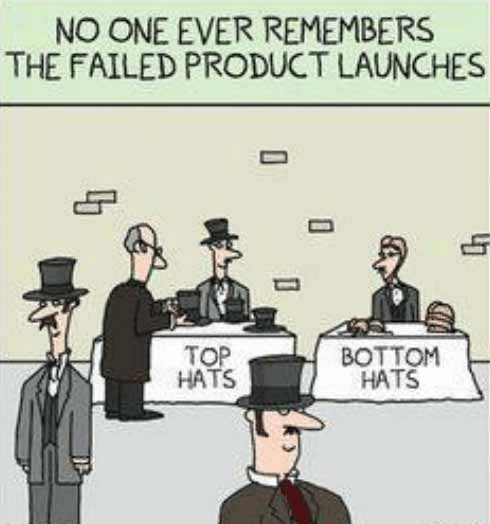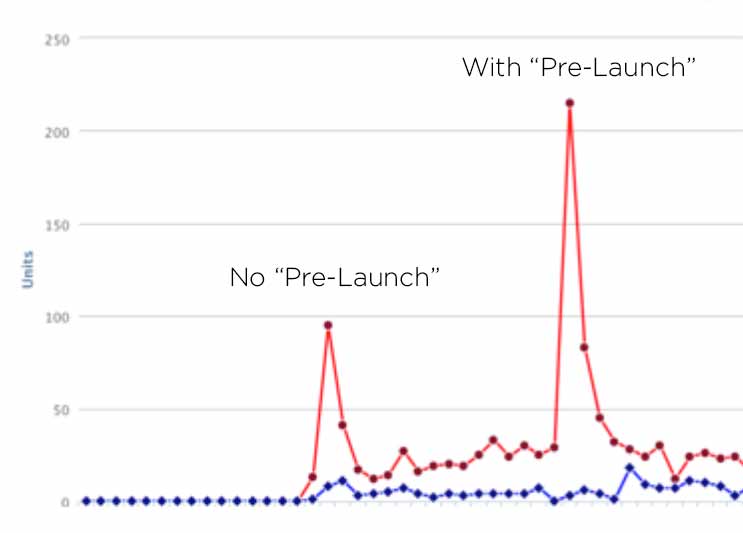 ^^ With any successful launch, you should know EXACTLY where you’re going to end up, long before the first email ever gets sent out (unlike this guy)
^^ With any successful launch, you should know EXACTLY where you’re going to end up, long before the first email ever gets sent out (unlike this guy)
We’ve already covered a process you can use to come up with ideas and a structure to use for every email you send out.
But how does this work during a launch or promotion? How do we drive the RIGHT action from our audience?
The process is similar, but with a few major tweaks that make all the difference.
“At the centre of your launch, you need one *big idea* and a compelling story that weaves its way through every email you send - to hook your readers and take them down the path towards the sale.”
Before we dig into the NES principles of a launch or promotion (Nurture, Excite, Sell), it’s worth covering a couple of supporting points. Specifically:
A big question that keeps coming up….
“My open rates are X% and my click rates are X%. Is this good?”
Or, “Only X% are opening my emails! What am I doing wrong?”
First, let’s clarify a few things.
Your open rates and click rates are NOT the most important thing in the world – not in themselves. Instead, they are ONE measure of how interested your readers are in a given topic at a given time.
Is that open rates and click rates are NOT the goal in themselves. Having a 30% click rate and 75% open rate is great for bragging rights… but what business objective is this hitting? What are the actions you’re driving and are they the right actions?
During the video on page 1 I showed you one of our “funnels” – one with a very high open/click rate and one with a much lower open/click rate. The funnel with the lower click rates earns many times more than the other.
The “click” is not the goal. It’s the ACTION you want the reader to perform by the time the email or email sequence has finished.
That might be sales, reviews, book downloads, or whatever.
Measure the results based on TOTAL ACTIONS. Then look at your open / click rates to see what might be improved.
This will depend hugely on your audience, but common “fixes” can include:
These are the “rules” that email marketing lives by. Be interesting. Be relevant. Build excitement. Drive the right actions. Keep a “high quality” list.
We’ve explored how to do this with email “broadcasts” – eg, sitting down and writing an email to send out that day or in the near future – but what about a launch or promotion that might span several weeks?
Using the NES (Nurture, Excite, Sell) phases, we can take what we’ve learned already and use our email marketing to drive maximum exposure.
 ^^ Wise words. The “Butt Head” Corporation didn’t nail their NES plan.
^^ Wise words. The “Butt Head” Corporation didn’t nail their NES plan.
Every successful launch or promotion includes three specific stages:
The objective, “tone”, and content of your emails during these three phases is going to be slightly different. But the good news is, we can use the same process we explored on the previous page.
Except this time, instead of using that structure to write ONE email, we’re going to use it to create an entire series of emails – which can be pre-written ahead of time and scheduled to go out automatically (or, you can write them “live” if you prefer – up to you).
Remember AIDA?
Attention, Interest, Desire, Action…
Instead of trying to cover ALL of those factors in one email, we use our launch series to move through each phase of AIDA over the course of 3-4 weeks.
By doing this, we can overcome common “reader objections” or “barriers to sale” to maximise our sales during the launch or promotion.
By moving our readers through each stage of AIDA and creating a compelling “idea” and story that weaves through the launch sequence, we can work through each of these barriers without readers even knowing they exist.
End result? More sales, less stress, happier readers:
 ^^ the peak on the left had no pre-launch series. The peak on the right did. You can see the difference.
^^ the peak on the left had no pre-launch series. The peak on the right did. You can see the difference.
Usually, I recommend setting aside 1 week for each phase of the launch – pre-launch, launch, and post-launch – 3 weeks in total. You can go longer if you like.
The number of emails you’ll want to send during this time will depend on your audience, but as a minimum, I’d recommend:
These emails might be spread out over 3 weeks, 4 weeks, or longer. And remember, during this launch period you need to move through each phase of AIDA and overcome those “barriers to sale”.

Remember, we use the Objective – AIDA – Tone – Idea – HTOC process explored on the previous page to write each email. In this case, we can focus on one or two aspects of AIDA in each email – as the series moves towards launch day – ramping up towards “Action” on launch-day itself.
Or, in other words, we build up the excitement and anticipation to drive as many actions (sales) as possible on launch day through to the end of the launch week.
Note: a lot of you will be thinking: “Seriously, I need to email people three times a week? Won’t they get sick of me and unsubscribe?”
Let me show you something:
(In the example above, I showed you a sequence where readers got a welcome email, a follow-up email, then one last email a week later. The unsubscribe rate was 0.7%. The other sequence sent out an email every day for 16 days. The unsubscribe rate was 0.1%. Frequency is something to bear in mind for your audience – but it’s NOT the main reason for unsubscribers!)
The upshot is – yes, you’ll get unsubscribers. BUT, your overall percentage-per-email shouldn’t change by much. In other words, if you get a 0.5% unsubscribe rate for each email normally, you should expect the same numbers during a launch.
The main thing for you to worry about is leading those readers on the right journey towards the sale, and focusing on delivering the right value to the right people.
![]()
We’ve got the structure and process for writing each email figured out. We’ve nailed the structure of the launch itself – through those three stages (pre-launch, launch, post-launch) and the four elements of AIDA.
Check.
Now it’s time to “fill in the gaps” with writing the right content to overcome those four barriers to sale, and move through each phase of AIDA as we near launch day.
Here’s how to overcome those barriers:
Ever get an email from a company and wonder how the heck you got on their mailing list in the first place? Or why they could possible think what they do is relevant to you in any way? Yeah, me too. Avoid this at all costs.
Overcoming this first barrier is an opportunity to remind your readers why they’re on your email list in the first place. Perhaps they downloaded one of your books. Perhaps they opted in another way. Whichever route, now’s the time to remind people how great your books are and why THEY will enjoy them.
If you’ve ever wondered why publishers stick “If you liked [FAMOUS AUTHOR] you’ll love [NOT FAMOUS AUTHOR]” or “Sensational! [NOT FAMOUS AUTHOR] is the new [FAMOUS AUTHOR]” blurbs on everything? Well, this is why. Now it’s your turn to do it in a less crappy way.
![]()
You might have the best book in the world, but if it looks like garbage nobody’s going to buy it. Hopefully, you’ve invested in some good cover designs and you’ve got some great reviews on your previous books (or will soon). Now’s the opportunity to pimp out your accomplishments and build up those “trust markers”. Don’t lose sales because readers think you’re not up to scratch.
A plague of the non-fiction world especially, this is often known as “special snowflake syndrome” and I can guarantee you that if you write “how-to” books, you’ll have some people on your list who will find any reason it might not work for them.
“Okay, you’re teaching digital marketing for Youtubers. But I’m left handed and like grapefruit juice. Will this work for me?”
An extreme example, perhaps. But joking aside – people WILL find reasons to worry that, for some reason, they aren’t a good fit for what you’ve got.
Ever watch a late-night infomercial? Or watch The Shopping Channel? Every time I catch them, I can’t tear my eyes away. It’s fascinating.
And a major reason these guys SELL is they feature countless testimonials, case studies, and user reviews from people in a wide range of circumstances. Men, women, old, young, rich, poor, average, attractive, unattractive, fat, thin, whatever.
In other words, they try to stamp out “special snowflake syndrome” at every opportunity.
It’s less of a concern for fiction, but if you write in a super-specific niche it’s always worth reinforcing how you serve your core readership – give people a reason to KNOW your book is going to be awesome for THEM.
This is where case studies, testimonials, reviews from different demographics, and samples / previews can be very powerful.
![]()
The killer of all online sales. When something is available so easily and quickly (like ebooks) it’s common for readers to “do it later”.
Which, of course, means they never will.
So, it’s your job to give people a compelling reason to buy NOW.
Including special launch-day bonuses or limited-time price reductions (like Bookbub does) work wonders here. You can do either, or both, as you see fit. So long as the offer both adds value and is for a limited time, you can nip procrastination in the bud.
Let’s break it down.
We’ve got a process to write each individual email. We’ve got a structure and AIDA plan for our launch. Now we need the “big idea” or the “central story” to tie everything together.
This story should weave through all your emails, providing a common theme and creating a desire in your readers to “find out more” at the end of each communication from you.
This doesn’t mean “come up with a random story in each email” – instead, you’ll use a longer story arc that plays out over the course of your launch emails.
Want more depth on that? Check out this video with André Chaperon:
The short version: create a story arc for your launch emails that develops towards a climax as the emails progress – leaving the reader “wanting more” at the end of each email.
(Hey, if you can do this with books, you can do this with emails – it’s a lot less complicated)
While incorporating elements of your story, you’ll also be including the specific features to overcome those objections and move readers through AIDA.
It might sound complicated, but in practice it’s not. Let’s take an example:
![]()
Julie writes historical romance, and her new book – the start of a new series – is set exclusively in Elizabethan England, in the court of Queen Elizabeth herself, during the late 1500s.
Julie has included lots of historical events in her book, including assassination attempts on the queen, violent rebellions, executions, and the attempted invasion of England by the Spanish Armada.
Knowing she needs an overall “story arc”, Julie takes elements of her book and frames it as a question to her readers: “How would your relationship survive assassination attempts, murder, and foreign invasion?”
This “theme” runs through Julie’s email series – posing the question, while giving real-life (or made-up) historical examples of people living through those dangerous times – culminating in either a “happily-ever-after” ending by the end, or something less optimistic…
Splitting the “story arc” into six parts, Julie plots out what she’s going to write about for each part of the story, and how she can end on a cliffhanger at the end of each email.
Julie also plans out what she’ll include in her emails to overcome barriers to sale and how to set the “objective” and “tone” of each email to move her readers through AIDA.
In other words, she’s using elements of what her book is already about to craft story “snippets” to weave through her email series. Like this:
![]()
Objective: Sales
AIDA: All of it
Tone: “Entertainment” with some “Inspiration” focus. “Information” used to drive the calls to action only.
Email 1 – “Attention” – Pose the question “would your relationship survive?” in the setting of the book’s historical context. Tease the upcoming release and some bonuses, promise to share some real-life examples and a cover reveal.
Email 2 – “Attention and Interest” – Share one historical example of “lovers in jeopardy”. Reveal cover. Tease more info on characters and historically accurate plot. Reveal launch-day bonuses.
Email 3 – “Interest and Desire” – Share another historical example. Detail what research has gone into the book. Introduce main hero / heroine and main antagonist, conflict, and stakes. Show snippets of reviews for previous books and any early beta-reader feedback. Link to chapter 1 preview. In PS, remind readers of the launch bonuses and deadline.
Email 4 – “Desire and Action” – Announce book is live. Re-cap on bonuses. Strong call-to-action. Underneath call to action remind readers of strong reviews. Hint at another “lovers in jeopardy” story, but this time with a happy / not happy ending.
Email 5 – Desire and Action” – Tell the story teased in previous email. Ideally this story should be different to the others (eg, not a happy ending, or a famous story everyone gets wrong). Link to characters in the new book. Remind of strong reviews. Another reminder of bonuses and strong call to action.
Email 6 – “Action” – briefly remind readers WHY you’re telling them these stories (eg – “these people refused to miss their chance”) and tie into the launch bonus deadline closing in a few hours. Strong call to action, even include an animated countdown timer if appropriate.
Email 7 – “Attention and Action” – follow up after the launch and ask readers if they enjoyed the stories, and to provide any feedback on the content they’d like to get going forward (eg – using a survey). Use the data to clean your list and plan your next campaigns.
![]()
This is just an example of a “launch plan” or “promotion plan”. While the specific details will vary depending on your genre or audience, the overall objectives and structure remains the same. The “story” we weave through the launch (“lovers in jeopardy”) is what ties everything together and provides the value outside of the launch (eg – if you take out all the “sales” parts, the remaining email is still entertaining / inspirational / educational).
If anything, writing fiction makes it easier to come up with your “big idea” – or your narrative arc.
But it’s the same with non-fiction too. For example, when I released EMU I introduced readers to the characters of “Blast ’em Bobbie” and “Strategic Sam”.
Each character had a backstory, based on traits and examples from real-life responses from my readers.
This “story arc” culminates in the experience of identifying with the character of “Bobbie” and understanding the route towards becoming more like “Sam”.
It’s a simple story. But it’s a “big idea”.
Your launch series can be planned out well in advance – so when it’s time to “sit down and write” you already know exactly what you’re going to say.
The emails are then queued up in your email software, and you’re ready to launch.
![]()
Once you’ve written the emails and run the campaign, you can use these “old” emails to create templates to use again and again with NEW subscribers.
So, instead of coming up with new ideas and drafting out emails every single day, take your best-performing ones and use them in automated sequences. You can run “launches” or “promotions” for your books 24/7, exposing the right books to the right people at the right time.
On the next page, we’re going to look at exactly how to set all that up – to give you an email marketing “machine” that’s constantly bringing in new readers and sending them the right messages at the right time. This is where we get to scale up our efforts massively. Click below to continue:
Good – leave a comment below, and then tell me – what launch “story” can you use to weave through your campaign? I’d love to hear about it below:
NB: you might need to be logged in to Facebook to see the comments section.
© Your First 10,000 Readers
Privacy | Terms | Disclaimer